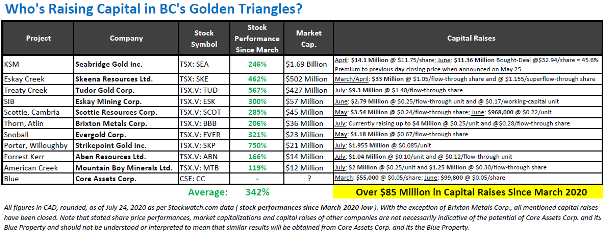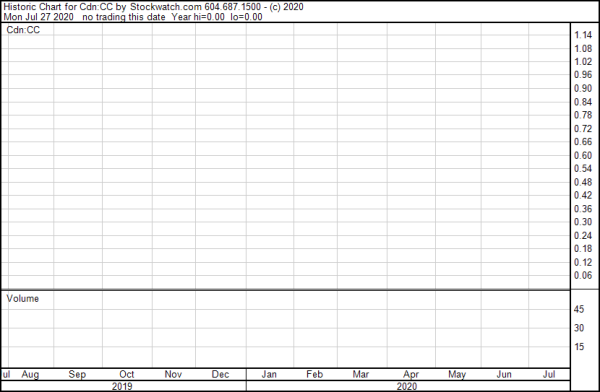Disseminated on behalf of Core Assets Corp. and Zimtu Capital Corp.
Today at market open in Canada, the shares of Core Assets Corp. are expected to commence trading on the CSE under the symbol “CC“. As management and insiders control over 60% of the 21.2 million issued shares under an Escrow Agreement, a tight shareholder structure has been created with no warrants or options currently outstanding. With its Blue Property near Atlin in north-western British Columbia, Core Assets is on a mission to delineate a gold-silver-copper skarn and/or porphyry deposit similar to those found in the prolific Golden Triangle exploration and mining region.
Gold and copper prices are on fire, and investors are pouring loads of money into one of the world‘s hottest mining plays: British Columbia‘s Golden Triangle.
Many of the world‘s largest gold, silver and copper deposits have been found in the Golden Triangle, however due to a combination of factors (e.g. low gold prices and a lack of infrastructure), the region was laying dormant for a while.
Now, the picture has changed completely: The Golden Triangle is re-awakening big time – thanks to major new discoveries made with modern exploration methods and massive infrastructure projects being completed (e.g. new highways, ocean port facilities, high-voltage transmission lines).
Since March 2020, the USD prices for gold and copper have soared by 30% and 40%, respectively, during which time over $80 million CAD of capital was raised for advancing projects in the Golden Triangle. The sleepy days are over, the hotbed for mineral discoveries and riches is readily awake now and at the center of investors‘ attention.
Despite over 130 million ounces of gold, 800 million ounces of silver and 40 billion pounds of copper already found in Golden Triangle‘s rugged terrain, significant discovery potential remains. With glacial ice and snow retreating in many parts of the region, new geological explanations and modern exploration methods are paving the way for new discoveries in the making.
The gold rush in the Golden Triangle has already started, with dozens of companies actively exploring projects to create shareholder value and to refine the boundaries of the triangle.

Full size / Select exploration, development and mining projects in the “Golden Triangles“ of British Columbia (Greens Creek Mine located in Alaska). Above stated numbers may be rounded, from companies‘ public disclosure (Koz = thousand ounces; Moz = million ounces; Blb = billion pounds; Eq = Equivalent; M+I = Measured & Indicated Resources; P+P = Proven & Probable Reserves). Note that results of above stated past producers, active mines, exploration and development projects in the region are not necessarily indicative of the potential of the Blue Property and should not be understood or interpreted to mean that similar results will be obtained from the Blue Property. The historical information in reference to the drill hole (1973) on the Blue Property from Core Assets Corp. is relevant only as an indication that some mineralization occurs on the Blue Property, and no resources, reserve or estimate is inferred. A qualified person has not done sufficient work to classify the historical information as current mineral resources or mineral reserves; and neither Rockstone nor Core Assets Corp. is treating the historical information as current mineral resources or mineral reserves.
Historical Exploration
The Blue Property has undergone some historical exploration programs in the past, focusing mainly on the copper-gold-silver mineralization in skarns.
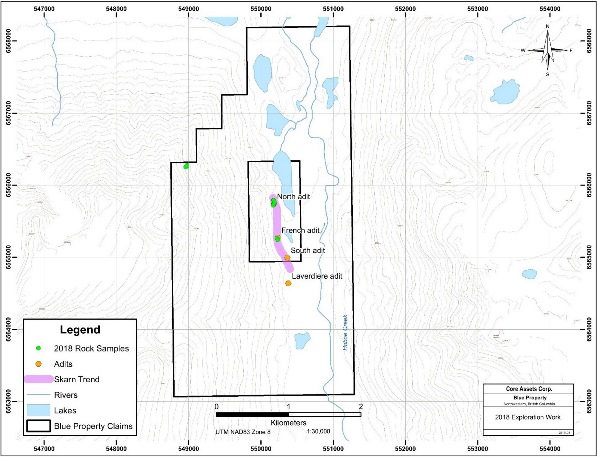
Full size / The Blue Property (1,126 hectares) is located 48 km southwest of Atlin, BC. (Source)
“Exploration on the Blue Property began in 1899... the Laverdiere brothers, drove four adits, worked a drift, and open cuts. The four adits are referred to as the North adit, the French adit, the South adit, and the Laverdiere adit. The North, French, and South adits were respectively driven for lengths of 6 m, 47 m, and 65 m; the Laverdiere adit caved and its length is unknown (White, 1971).” (Source: Technical Report on the Blue Property, 09/2019)
“In 1973 Rio Plata Silver Mines Ltd. commenced diamond drilling on the property yielding 175.0 meters of 0.27% copper from surface, including 27.0 meters of 1.2% Cu approximately 15 meters south of the “French Adit.” (Source)
“The historic French adit, which is still accessible, transects a magnetite skarn and truncates approximately 47 m from its portal against the granodiorite...Historic drilling on the Blue Property, conducted by Rio Plata Silver Mines Ltd. in 1973, also encountered copper mineralization in DDH 2-73, that Fustos (1974), describes as “porphyry type”... The well-fractured and moderately altered granitic rock of DDH 2-73 from 0 to 175.4 m, had an average copper grade of 0.27%; scheelite was also observed... Rio conducted a 176 line-kilometer aeromagnetic survey between August 6 to August 8, 1973. The aeromagnetic survey indicated a new area of skarn mineralization and two areas of possible porphyry mineralization (Nielsen and Phelps, 1973).” (Source: Technical Report on the Blue Property, 09/2019)
The historical information is relevant only as an indication that some mineralization occurs on the property, and no resources, reserve or estimate is inferred. A qualified person has not done sufficient work to classify the historical information as current mineral resources or mineral reserves; and neither Rockstone nor Core Assets Corp. is treating the historical information as current mineral resources or mineral reserves.

Full size / Mineralized talus below an outcrop exposure (found during the 2018 exploration program which “confirmed the copper, silver, and gold mineralization potential of the Blue Property.”) (Source)
2018 Exploration Program
The 2018 exploration program on the Blue Property “consisted of the collection of 28 rock grab samples: four grab samples from bed rock in the historical “French Adit” sampled every 10-12 meters; six grab samples from the exterior area of the “French Adit” (rubble from potential mine dump); and two samples from bedrock, 10 meters south of the “French Adit”. Eleven samples were taken from bedrock in the area of the historical “North Adit” and five samples were collected from areas of the northernmost extent of the property. All areas of sampling returned very promising assay values. Rocks sampled from the “French Adit” area assayed up to 1.56 g/t gold, 43.3 g/t silver and 8.46% copper. Rocks sampled from the “North Adit” area assayed up to 1.57 g/t gold, 46.5 g/t silver and 1.86% copper.” (Source)

Full size / Mineralized outcrop exposure with a malachite (Cu2[(OH)2|CO3]) rind on weathered surface. (Source)

Full size / Mineralized outcrop exposure with a malachite (Cu2[(OH)2|CO3]) rind on weathered surface. (Source)
According to the Technical Report on the Blue Property (09/2019):
“Mineralized Zones: Mineralization on the Blue Property is hosted by a magnetite skarn with the principal observed ore minerals represented by magnetite and iron-copper sulphides; these are accompanied by variable amounts of gold and silver based on assay values.
”Deposit Types: The Au-Ag-Cu mineralization of the Blue Property is hosted by an Fe (Cu) classed skarn known as the Laverdiere prospect (Ray, 1997). Fe skarns are characteristically controlled by pluton margins, stratigraphic contacts, and local structures (Ray, 2013). Morphologically, Fe classed skarns typically occur as sheets, massive lenses, or stratiform bodies... There are at approximately 735 skarn occurrences in British Columbia and of these roughly 146 of them are classed as Fe skarns. Tectonically, Fe skarns are associated with rifted continental margins, synorogenic continental margins, and island arcs. While many skarns are barren, it is also possible for them to contain significant quantities of economic minerals such as Au, Sn, Fe, Cu, Mo and W. (Ray, 2013)... Ore mineralogy in Fe skarn deposits is characterized by magnetite with subordinate minerals including but not limited to chalcopyrite, pyrite, cobaltite, pyrrhotite, arsenopyrite, sphalerite, galena, molybdenite, bornite, hematite, martite, and gold... A proxy for porphyry systems is a spatially and genetically associated volume of hydrothermally altered/mineralized rock, like magnetite skarns. Porphyrys vary in size from relatively small systems consisting of a few million tonnes, to giants of a few billion tonnes; mineralization in these types of systems usually occurs as vein stockworks that host disseminated sulphides of copper, like chalcopyrite, and may have accompanying tungstates, like scheelite. Cu grades in porphyry systems commonly grade from 0.2% to 2%.“

Full size / Visible bornite (Cu5FeS4) in magnetite-rich limestone collected in 2018 from outside the “French Adit” on the Blue Property. The striking iridescence of blue to purple tarnish gives bornite its nickname “Peacock Ore“. (Source)

Full size / Malachite (Cu2[(OH)2|CO3]) rind on weathered surface of an outcrop on the Blue Property. (Source)
2019 Exploration Program and 2020 Plans
Work completed by Core Assets to date on the Blue Property consists of a 2D resistivity/induced polarization geophysical survey over a portion of the property in June 2019.
According to the Technical Report on the Blue Property (09/2019):
“[...] additional anomalous zones of high chargeability and low resistivity occurring approximately 150 m below the modeled topography have been identified... The 2019 resistivity/induced polarization, geophysical survey successfully confirmed the ability to detect skarn mineralization at depth based on the known surface extents and historic drill logs. Additionally, the survey identified moderate chargeability anomalies up the hillside to the west of Hoboe Creek that can be drill tested... this area has mapped exposures of granitic rocks and therefore are considered to be porphyry style mineralization targets, similar to the mineralization recorded in historical DDH 2-73.“

Full size / Source: Core Assets’ Prospectus of July 7, 2020 as filed on SEDAR.
Regional & Property Geology
“A major regional structure, the Llewellyn fault, juxtaposes the Nisling terrane, a Proterozoic to lower Paleozoic aged continental margin assemblage (west), against the Upper Triassic to Middle Jurassic northern Stikine terrane (east)... The Llwellyn fault exceeds 100 km in length, striking northwest from the Tulsequah area to the British Columbia-Yukon border. It is characterized as a steeply dipping, brittle dextral strike-slip structure (Mihalynuk et al., 1994, 1999)... In this area, the Stikine terrane is comprised of Upper Triassic strata belonging to the Stuhini Group; this group consists of limestones, arkosic sandstone, basaltic flows and breccia, debris-flow conglomerate, turbiditic volcanic sandstone, and argillite (Bultman, 1979; Milhalynuk and Mountjoy, 1990). The northwestern part of the Stikine terrane is an exceptionally prolific area for economic ore deposits and has been dubbed “The Golden Triangle”. The rocks of this area are known to host volcanogenic massive sulphide, alkaline porphyry Cu-Au, and epithermal precious metal deposits.
”Exposures of lithologies belonging to the Stuhini Group are poorly represented on the Property, dominantly occurring along its eastern or northern borders. The lowermost unit of the Stuhini Group, east of the Llwellyn fault zone, is a sheared, brecciated, and locally calcite veined basalt. Intrusive granitic units on the Blue Property are comprised of biotite granite to granodiorite and biotite-hornblende granite to alaskite. These granitic intrusions dominantly span a temporal range from the Late Triassic to the Mid-Cretaceous, though younger intrusives of smaller relative volumes occur throughout the area (Jackson et al., 1990).
”The Blue Property straddles the eastern boundary of the Coast Belt and the western boundary of the Intermontane Belt ... along the Hoboe Creek Valley in the Canadian Cordillera... The Coast Belt is comprised of mainly granitic rock spanning a Jurassic through Cenozoic temporal range. The remainder of the Coast Belt are Proterozoic, at the latest, to Holocene complexly deformed, high grade metamorphic sedimentary and volcanic rocks formed in magmatic arcs or accretionary complexes (Monger and Price, 2002). The Intermontane Belt in northwestern British Columbia is represented by the Stikine physiographic unit. Sedimentary, granitic, and volcanic rocks geologically define the Intermontane Belt spanning the following facies and temporal ranges: Devonian to Early Jurassic island arcs and accretionary complexes; Middle Jurassic to Cenozoic continental arc, marine, and terrestrial clastics; Devonian to Cenozoic granitic rocks (Monger and Price, 2002).” (Source: Technical Report on the Blue Property, 09/2019)
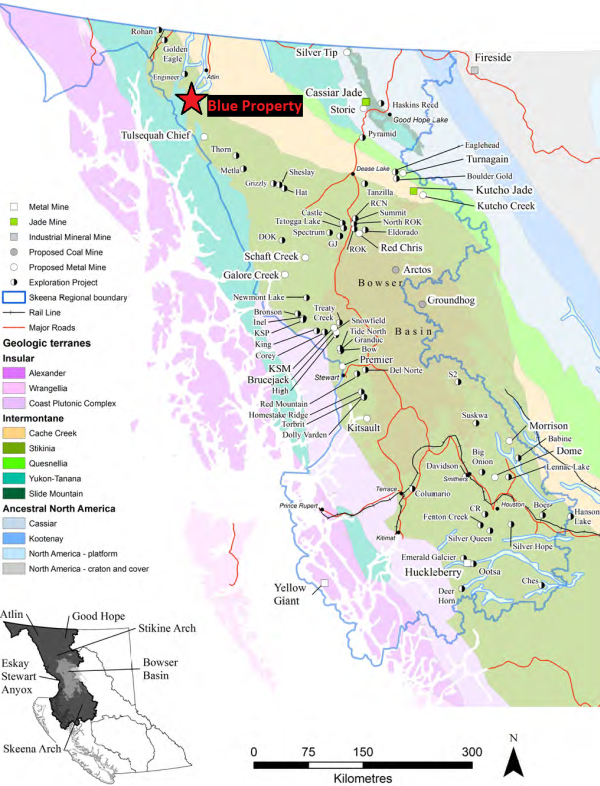
Full size / Active mining and exploration projects Skeen Region, 2014 (Blue Property added by Rockstone) Source: Kyba, J., 2015. Exploration and mining in the Skeena Region, British Columbia. In: Exploration and Mining in British Columbia, 2014. British Columbia Ministry of Energy and Mines, British Columbia Geological Survey, Information Circular 2015-2, pp. 97-114

Full size / Source: Explorationsites.com
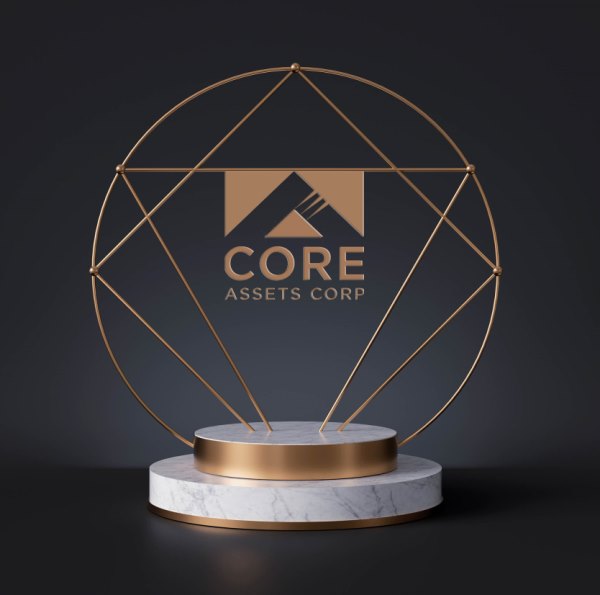
Core Assets: Reshaping BC´s Golden Triangle
Company Details

Core Assets Corp.
Suite 1450 – 789 West Pender Street
Vancouver, BC, V6C 1H2 Canada
Phone: +1 604 681 1568
Email: info@coreassetscorp.com
www.coreassetscorp.com
Incorporation Date: April 20, 2016
Listing Date: July 27, 2020
CUSIP: 21871U05
ISIN: CA21871U1057
Shares Issued & Outstanding: 21,216,000
Canadian Symbol (CSE): CC
Current Price: -
Market Capitalization: -
German Symbol / WKN: Not Listed
US Symbol: Not Listed
Contact:
Rockstone Research
Stephan Bogner (Dipl. Kfm.)
8260 Stein am Rhein, Switzerland
Phone: +41-44-5862323
Email: info@rockstone-research.com
www.rockstone-research.com
Disclaimer: This report contains forward-looking information or forward-looking statements (collectively "forward-looking information") within the meaning of applicable securities laws. Forward-looking information is typically identified by words such as: "believe", "expect", "anticipate", "intend", "estimate", "potentially" and similar expressions, or are those, which, by their nature, refer to future events. Rockstone Research, Core Assets Corp. and Zimtu Capital Corp. caution investors that any forward-looking information provided herein is not a guarantee of future results or performance, and that actual results may differ materially from those in forward-looking information as a result of various factors. The reader is referred to Core Assets Corp.´s public filings for a more complete discussion of such risk factors and their potential effects which may be accessed through its profile on SEDAR at www.sedar.com. Please read the full disclaimer within the full research report as a PDF (here) as fundamental risks and conflicts of interest exist. The author, Stephan Bogner, holds an equity position in Core Assets Corp.,as well as in Zimtu Capital Corp., and is being paid by Zimtu Capital Corp. for the preparation, publication and distribution of this report, whereas Zimtu Capital Corp. also holds a long position in Core Assets Corp. Note that Core Assets Corp. pays Zimtu Capital Corp. to provide this report and other investor awareness services. Zimtu Capital Corp. is an insider and control block of Core Assets Corp. by virtue of owning more than 20% of Core’s outstanding stock. Core Assets Corp. has one or more common directors with Zimtu Capital Corp. The cover picture and picture at the end (both amended) have been obtained and licenced from Sunward Art and wacomka, respectively.

